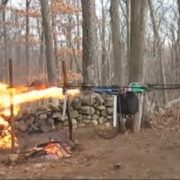The one city in the San Francisco Bay area that I would expect to have bad police-community relations would be Richmond, California. I never ever felt safe there.
I don’t scare easily. In the early 90s, when I worked in an Oakland office, my secretaries reported to me that they heard automatic gun fire every night. Yet, when I walked around Oakland (often stepping over hypodermic needles), I never felt threatened.
On the other hand, Richmond, which is located across the bay from Marin County and north of Berkeley, had a dangerous vibe in those years. None of my friends would go there (not even the guy who once lived in the slums of India).
Once I stopped at a train station in Richmond and saw a crowd of about a dozen or so middle-school children running. I asked them what was going on. A boy laughed and said, “We stole a gun from a cop.” He looked about 10-years old.
This is why I was greatly surprised to learn that Richmond has had not only a dramatic drop in homicides, but an astoundingly low rate of police officer caused shootings. Common sense measures almost eliminated civilian deaths at the hands of law officers.
I asked Albaro Ibarra, AMREL’s Senior Marketing Manager, and former police officer what he thought of the article that described the low level of police-involved shootings. He replied,
“Great piece. In my Academy days they taught us to respond with the level of force that was needed. The dangerous thing was that each officer had their own opinion about the level of threat they were in. There were some officers that were more likely to pull out their weapon because they felt there was a threat. Maybe it was because of the officer’s personal strength or their lack of confidence in being able to scale down a situation.
“A good example of this was when we confronted a very upset lady who was wielding a knife. The situation around us was tense and some officers pulled their guns. One of our lead officers was an ex-NBA player and self-defense trainer. He never pulled out his gun. His confidence in his abilities resulted in him disarming her without firing a shot.
“I believe we didn’t get enough or any training on how to scale down a situation. That would have been very helpful to develop greater confidence within the officers to know that they could handle a situation without pulling their side arms.
“The article touches on how there’s a level of trust between Chief Chris Magnus and the Richmond community. I saw this with veteran officers who often worked the day shift. They enjoyed engaging with the community, and built personal relationships. They would often like to do their work on foot, not in vehicles.
“Some of the new officers, who often worked the night shift, were driven by violence and adventure. They had less community involvement and escalated situations more frequently.
“During those times we lacked the computer technology that AMREL (rugged mobile computing and biometric solutions) today offers to the Public Safety sector. The ability to be more mobile and be amongst the community helped reduce the feeling of US against THEM and develop more a feeling of ALL OF US. Utilizing the modern technologies that are now offered would have made my work more efficient, and engage more with community. It would have increased the feeling that the Police Department is there to Serve and Protect and not just to Enforce.”
The following article was originally published in Vox
You don’t expect to see a police chief at a protest against police brutality. But when Richmond, California held a protest against recent police shootings of unarmed black men, Richmond’s police chief, Chris Magnus, was there on the front lines, holding a #BlackLivesMatter sign.
Magnus was criticized by his local police association for his appearance at the protest — the association claimed that they didn’t have any problem with the message, but it was against California law for him to appear in “political activities of any kind” while in uniform. But Magnus is clearly doing something right in Richmond, a Bay Area town of 107,000. When Vox talked to Magnus earlier this year, the cops hadn’t killed a civilian in five years. (A Richmond police officer fatally shot a civilian on September 14th, 2014.)
Magnus cautions that “policing is local,” and that what works for his department might not be appropriate for others. But here are some lessons he’s learned about leading a department that doesn’t use force as a first resort.
1) Don’t recruit cops by promising violence and adventure
“You have to be thinking, as a police administrator, about what kind of folks you want to attract to your department, and how you do that. You look at some departments’ recruiting materials, and you see guys jumping out of trucks in SWAT gear and people armed with every imaginable weapon. There are clearly situations where that is a necessary and appropriate part of police work. But having said that, that is by far and away not the norm.
“My goal is to look for people who want to work in my community, not because it’s a place where they think they’re going to be dealing with a lot of violence and hot chases and armed individuals and excitement and an episode of Cops or something. I want them tactically capable to handle situations like that, but I want them to be here because they’re interested in building a partnership with the community. They’re not afraid to have a relationship with the residents that they serve, in terms of getting out of the car and talking to people. Those are messages that have to be sent early on, before people even get hired.”
2) Train officers not just in what they can do, but in how to make good decisions
“It’s important that officers have training that involves more than just being proficient in the use of a firearm. Obviously that’s something they need to be able to do, but a big part of our training around use of force, specifically with use of firearms, is training in decision-making under stress. How and when do you consider the use of deadly force? What are the other options that were available to you?
“There are still a lot of police academies in this country, whether they’re through police agencies, colleges, or other institutions, that are probably not as far along as they should be in some of these areas. As a field, we can do better.”
3) Give cops extra training in interacting with mentally-ill people — and teenagers
“We’ve done quite a bit of training, with our school resource officers and our juvenile detectives, about some of the better ways to communicate with youth — what approaches might be most appropriate if you have to use force. Some of that’s really about brain development, and we’re learning that young people really do respond differently than adults do.”
“We do a lot of training dealing with the mentally ill. We have officers on all of our shifts who have gotten even more detailed and involved training — crisis intervention training — dealing specifically with mentally-ill individuals. That covers understanding what the signs are that someone may be in a mental-health crisis, understanding about medications and the impact of those medicines that a lot of folks might be on, understanding what happens when they’re not taking their medication, and getting better knowledge on how to interact or engage with people who are in crisis.”
4) Training doesn’t stop when you get out on the street
“Our officers go through what is anywhere between six and eight months of additional training once they hit the streets. That involves being teamed up with other officers who are trained as trainers, and who provide them with ongoing and regular evaluation about what they’re doing and help them learn from their mistakes in a more controlled setting.”
5) Remember that you can kill someone with a Taser
“Part of the problem with Tasers out in the community is, perhaps, this particular piece of law enforcement equipment has been misrepresented to suggest that it always can guarantee a good, less-than-lethal outcome. And that’s not true. People have complicated health histories which you can’t possibly know, most of the time, when you’re dealing with them. There may be a lot of circumstances that complicate the use of a Taser that you couldn’t know in advance.
“The vast majority of our Taser use involves displaying it and informing the suspect that resisting arrest will result in them being tased. In other words, we don’t even necessarily deploy it. And that’s enough, most of the time.”
6) Be proactive in addressing officers who use a lot of force — before they become a problem
“We have a database in which we track each officer’s history in terms of how they use force. If we see an officer who seems to be using force more than somebody else, we take a more careful look at that. That doesn’t always mean that the officer is doing something wrong or that they’re just predisposed to use force. It might have to do with the area that they’re working, the incidents they’ve been dealing with. But it still never hurts that we look more carefully and try to be as proactive as possible in addressing a situation before it becomes, potentially, a problem.”
7) Don’t be afraid to fire someone who’s not cut out to be a police officer
“It’s hard when you’ve invested as much as a year or more into training somebody. But there are clearly some folks who can’t multitask, they can’t make good decisions under stress, they’re not effective communicators. For whatever reasons, they’re not cut out to be police officers. Part of the challenge of a professional police department is to make sure those folks are separated from service early on. So you have to be willing to do that — and to have the local political support within your city to do that.”
8) When force really is needed, a little community trust goes a long way
“The use of force is something that, when people see it, they’re horrified by it. Even though it may be completely legitimate and appropriate in a larger scheme, it’s not easy to watch, and it’s even more difficult to have to be part of.
“You have to have an underlying relationship with the community so that there’s a level of trust and understanding and people are willing to hear you out about why force was used in a set of circumstances. And the community can trust that when mistakes are made — which sometimes happens — your department’s going to learn from them so they’re not repeated.”
9) Police departments can’t do sufficient training without resources
“It’s totally appropriate and important that we have this national conversation about use of force. But I hope along with that is a commitment to the idea that it takes resources and financial support to do this kind of training. A lot of departments don’t even have the personnel that they need to handle many of these situations. They certainly don’t have the resources to commit to that type of training and equipment. So then you have cops that are really left with a knowledge gap and a resource gap. And I’ve worked in some smaller departments, where I’ve seen that it’s very tough.”


















